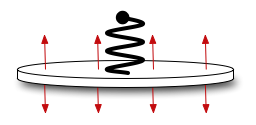One-Mass - Mono-directional (Harmonic Oscillator)
A simple and inexpensive mass and spring model that can serve as lips, among other things. The harmonic oscillator models a mass attached to a spring of a given stiffness, fixed at one end. The frequency of resonance of the object is given by the formula 1/(2 pi) sqrt(stiffness / mass).

(make-object 'harmonic-oscillator ... )
A 'harmonic-oscillator can be created using the following Lisp syntax (the default values are shown for each of the physical parameters):
(make-object 'harmonic-oscillator
(mass .01)
(stiffness 15000)
(freq-loss 100)
(const-loss 10))
All physical parameters can be numerical values or controllers.
- mass: The mass of the small mass in kg.
- stiffness: The stiffness of the spring in the 'normal direction.
- freq-loss: The usual frequency loss parameter. See the General Object Information for more info.
- const-loss: The usual constant loss parameter. See the General Object Information for more info..
As usual, the freq-loss and const-loss parameters control the rate of decay of the sound. The higher they are, the more damped the sound is.
The 'harmonic-oscillator can be accessed in only one direction: 'normal:
(make-access my-harmonic-oscillator my-controller 'normal)
Options
A harmonic-oscillator can be tuned to a specific pitch, using the (set-pitch ... ) function, by adjusting one of the following physical parameters:
- 'stiffness
- 'mass
For example:
(setq my-lips (make-object 'harmonic-oscillator
(mass 5e-3)
(stiffness 10)
(freq-loss 10)
(const-loss 1) ))
(set-pitch my-lips 'stiffness 220)
- Modalys
- Summary
- An Introduction to Modalys
- Getting Started
- Objects
- Object Properties
- Object Reference
- One-Mass - Mono-directional (Harmonic Oscillator)
- Two-Mass - Mono-directional
- Two-Mass - Bi-directional
- String (or Rod) - Mono-directional
- String (or Rod) - Bi-directional
- Tube - open/open
- Tube - closed/open
- Tube - closed/closed
- Rectangular Membrane - Fixed
- Circular Membrane - Fixed
- Rectangular Plate - Fixed
- Circular Plate - Clamped
- Circular Plate - Free
- Rectangular Free Bar
- Violin Bridge
- Cello Bridge
- Jet Object
- Single Point Object
- Radiator Object
- Clone Object
- Save Modal Object
- Read Modal Object
- Resonance Model Object
- Piano Soundboard
- Finite Element
- Object Utilities
- Hybrid Objects
- Accesses
- Connections
- Controllers
- The Modalys Workspace
- Finite Elements
- Appendix
- Index
